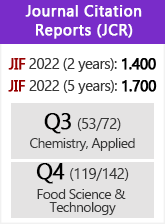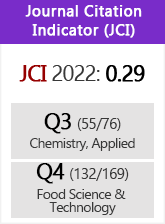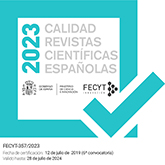Pickling process of capers (Capparis spp.) flower buds
DOI:
https://doi.org/10.3989/gya.1999.v50.i2.641Keywords:
Caper, Flower bud, PicklingAbstract
Middle sized (8 < x < 13 mm) buds of Capparis spinosa var. spinosa and C. ovata var. canescens from June in brines containing 5,10,15 and 20% salt and from August in brines of 15% salt, and three different size (x < 8 mm, 8 < x < 13 mm, x > 13 mm) buds of C. . ovata var. canescens from June in brines of 15% salt were pickled for two months fermentation. Some chemical and microbiological analyses were done in brines during fermentation. Most suitable salt concentration for lactic acid bacteria (LAB) activity were 5% and partly 10%. Acidity, LAB activity, sedimentation and hardness were reduced by increasing bud size in C. ovata. Small buds of C. ovata for pickling product had advantage for colour and flavour, however, more sediment and partly softening showed disadvantage. For both species, pickling time was determined as 40 to 50 days in regard of end-product flavour and odour, brine acidity and pH, and LAB activity.
Downloads
Download data is not yet available.
Downloads
Published
1999-04-30
How to Cite
1.
Özcan M, Akgül A. Pickling process of capers (Capparis spp.) flower buds. Grasas aceites [Internet]. 1999Apr.30 [cited 2024Jul.27];50(2):94-9. Available from: https://grasasyaceites.revistas.csic.es/index.php/grasasyaceites/article/view/641
Issue
Section
Research
License
Copyright (c) 1999 Consejo Superior de Investigaciones Científicas (CSIC)

This work is licensed under a Creative Commons Attribution 4.0 International License.
© CSIC. Manuscripts published in both the printed and online versions of this Journal are the property of Consejo Superior de Investigaciones Científicas, and quoting this source is a requirement for any partial or full reproduction.All contents of this electronic edition, except where otherwise noted, are distributed under a “Creative Commons Attribution 4.0 International” (CC BY 4.0) License. You may read here the basic information and the legal text of the license. The indication of the CC BY 4.0 License must be expressly stated in this way when necessary.
Self-archiving in repositories, personal webpages or similar, of any version other than the published by the Editor, is not allowed.
















